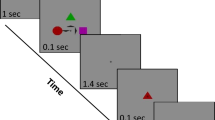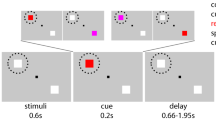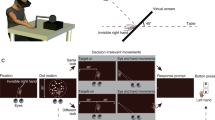Abstract
Intelligent behaviour requires self-control based on the consequences of actions. The countermanding task is designed to study self-control; it requires subjects to withhold planned movements in response to an imperative stop signal, which they can do with varying success. In humans, the medial frontal cortex has been implicated in the supervisory control of action1,2,3. In monkeys, the supplementary eye field in the dorsomedial frontal cortex is involved in producing eye movements, but its precise function has not been clarified4. To investigate the role of the supplementary eye field in the control of eye movements, we recorded neural activity in macaque monkeys trained to perform an eye movement countermanding task. Distinct groups of neurons were active after errors, after successful withholding of a partially prepared movement, or in association with reinforcement. These three forms of activation could not be explained by sensory or motor factors. Our results lead us to put forward the hypothesis that the supplementary eye field contributes to monitoring the context and consequences of eye movements.
This is a preview of subscription content, access via your institution
Access options
Subscribe to this journal
Receive 51 print issues and online access
$199.00 per year
only $3.90 per issue
Buy this article
- Purchase on Springer Link
- Instant access to full article PDF
Prices may be subject to local taxes which are calculated during checkout




Similar content being viewed by others
References
Coles, M. G. H., Scheffers, M. K. & Fournier, L. Where did you go wrong? Errors, partial errors, and the nature of human information processing. Acta Psychol. 90, 129–144 (1995).
Posner, M. I. & DiGirolamo, G. T. in The Attentive Brain (ed. Parasuraman, R.) 401–423 (MIT Press, Cambridge, Massachusetts, 1998).
Carter, C. S., Botvinick, M. M. & Cohen, J. D. The contribution of the anterior cingulate cortex to executive processes in cognition. Rev. Neurosci. 10, 49–57 (1999).
Schall, J. D. in Cerebral Cortex Vol. 12 (eds Rockland, K., Peters, A. & Kaas, J. H.) 527–638 (Plenum, New York, 1997).
Logan, G. D. & Cowan, W. B. On the ability to inhibit thought and action: A theory of an act of control. Psychol. Rev. 91, 295–327 (1984).
Hanes, D. P. & Schall, J. D. Countermanding saccades in macaque. Vis. Neurosci. 12, 929– 937 (1995).
Schall, J. D. Neuronal activity related to visually-guided saccadic eye movements in the supplementary motor area of rhesus monkeys. J. Neurophysiol. 66, 530–558 (1991).
Gehring, W. J., Gross, B., Coles, M. G. H., Meyer, D. E. & Donchin, E. A neural system for error detection and compensation. Psychol. Sci. 4, 385– 390 (1993).
Miltner, W. H. R., Braun, C. H. & Coles, M. G. H. Event-related brain potentials following incorrect feedback in a time-estimation task: Evidence for a “generic” neural system for error detection. J. Cogn. Neurosci. 9, 788–798 (1997).
Falkenstein, M., Koshlykova, N. A., Kiroj, V. N., Hoormann, J. & Hohnsbein, J. Late ERP components in visual and auditory Go/Nogo tasks. Electroencephalogr. Clin. Neurophysiol. 96, 36–43 ( 1995).
Dehaene, S., Posner, M. I. & Tucker, D. M. Localization of a neural system for error detection and compensation. Psychol. Sci. 5, 385– 405 (1994).
Niki, H. & Watanabe, M. Prefrontal and cingulate unit activity during timing behavior in the monkey. Brain Res. 171 , 213–224 (1979).
Gemba, H., Sasaki, K. & Brooks, V. B. “Error” potentials in limbic cortex (anterior cingulate area 24) of monkeys during motor learning. Neurosci. Lett. 70, 223–227 ( 1986).
Hanes, D. P., Patterson, W. F. & Schall, J. D. Role of frontal eye fields in countermanding saccades: Visual, movement and fixation activity. J. Neurophysiol. 79, 817–834 (1998).
Carter, C. S. et al. Anterior cingulate cortex, error detection, and the online monitoring of performance. Science 280, 747–749 (1998).
Botvinick, M. M., Braver, T. S., Carter, C. S., Barch, D. M. & Cohen, J. D. Evaluating the demand for control: Anterior cingulate cortex and crosstalk monitoring. Psychol. Rev. (in the press).
Amador, N., Schlag-Rey, M. & Schlag, J. Reward-predicting and reward-detecting neuronal activity in the primate supplementary eye field. J. Neurophysiol. 84, 2166–2170 (2000).
Schultz, W. & Dickinson, A. Neuronal coding of prediction errors. Annu. Rev. Neurosci. 23, 473– 500 (2000).
Hanes, D. P. & Schall, J. D. Neural control of voluntary movement initiation. Science 274, 427– 430 (1996).
Schiller, P. H. & Chou, I. H. The effects of frontal eye field and dorsomedial frontal cortex lesions on visually-guided eye movements. Nature Neurosci. 1, 248– 253 (1998).
Schall, J. D. & Taylor, T. L. Sequential effects in countermanding performance of macaque monkeys. Soc. Neurosci. Abstr. 24, 172–172 (1998).
Logan, G. D. Executive control of thought and action. Acta Psychol. 60, 193–210 (1985).
Norman, D. A. & Sallice, T. in Consciousness and Self-Regulation: Advances in Research and Theory Vol. 4 (eds Davidson, R. J., Schwartz, G. E. & Shapiro, D.) 1–18 (Plenum, New York, 1986).
Schlag-Rey, M., Amador, N., Sanchez, H. & Schlag, J. Antisaccade performance predicted by neuronal activity in the supplementary eye field. Nature 390, 398–401 ( 1997).
Chen, L. L. & Wise, S. P. Neuronal activity in the supplementary eye field during acquisition of conditional oculomotor associations. J. Neurophysiol. 73, 1101–1121 (1995).
Olson, C. R. & Gettner, S. N. Object-centered direction selectivity in the macaque supplementary eye field. Science 269 , 985–988 (1995).
Everling, S. & Munoz, D. P. Neuronal correlates for preparatory set associated with pro-saccades and anti-saccades in the primate frontal eye field. J. Neurosci. 20, 387– 400 (2000).
Sadeghpour, S., Schlag, J., Schlag-Rey, M., Mohempour, A. & Dorfman, A. Functional interactions between the supplementary and frontal eye fields in monkey. Soc. Neurosci. Abstr. 24, 522–522 ( 1998).
Heinen, S. J. & Anbar, A. N. Stimulation of the supplementary eye fields affects saccade timing. Soc. Neurosci. Abstr. 24, 1147–1147 (1998).
Penfield, W. & Welch, K. The supplementary motor area of the cerebral cortex: A clinical and experimental study. Arch. Neurol. Psychiatry 66, 289–317 ( 1951).
Acknowledgements
We thank K. Ruch for help with the experiments, K. Hodges for help with the anatomical reconstruction, J. Jewett for help with the figures, and M. Coles, J. Cohen, A. Graybiel, G. Logan, A. Murthy and S. Park for comments on the manuscript. This work was supported by the NIMH, DFG and NSERC.
Author information
Authors and Affiliations
Corresponding author
Supplementary information
Rights and permissions
About this article
Cite this article
Stuphorn, V., Taylor, T. & Schall, J. Performance monitoring by the supplementary eye field. Nature 408, 857–860 (2000). https://doi.org/10.1038/35048576
Received:
Accepted:
Issue Date:
DOI: https://doi.org/10.1038/35048576
This article is cited by
-
Conflict detection and resolution in macaque frontal eye fields
Communications Biology (2024)
-
Neurophysiological mechanisms of error monitoring in human and non-human primates
Nature Reviews Neuroscience (2023)
-
Cortical Deficits are Correlated with Impaired Stereopsis in Patients with Strabismus
Neuroscience Bulletin (2023)
-
Functional architecture of executive control and associated event-related potentials in macaques
Nature Communications (2022)
-
The unknown but knowable relationship between Presaccadic Accumulation of activity and Saccade initiation
Journal of Computational Neuroscience (2021)
Comments
By submitting a comment you agree to abide by our Terms and Community Guidelines. If you find something abusive or that does not comply with our terms or guidelines please flag it as inappropriate.



